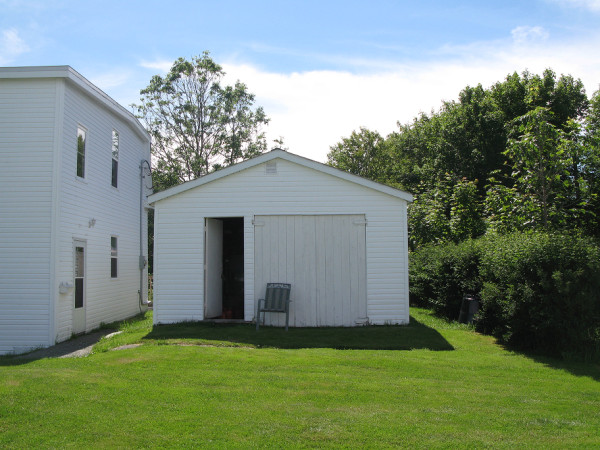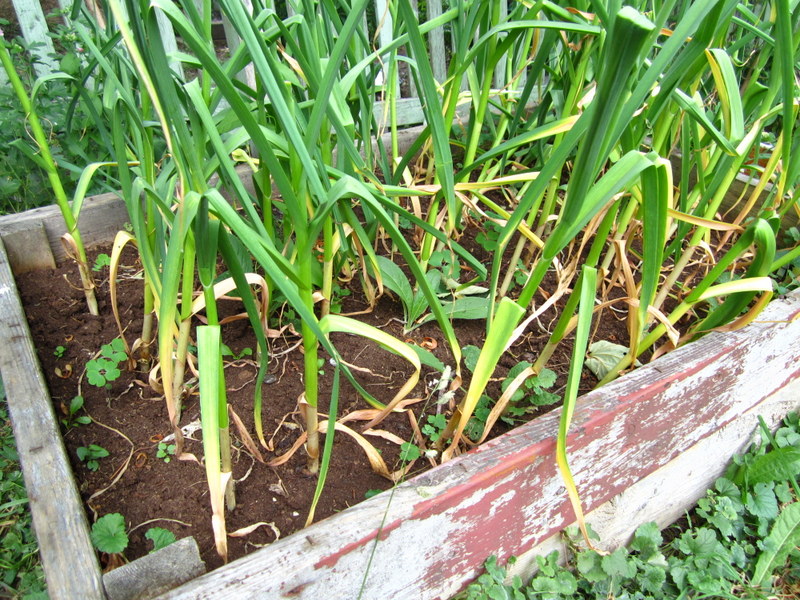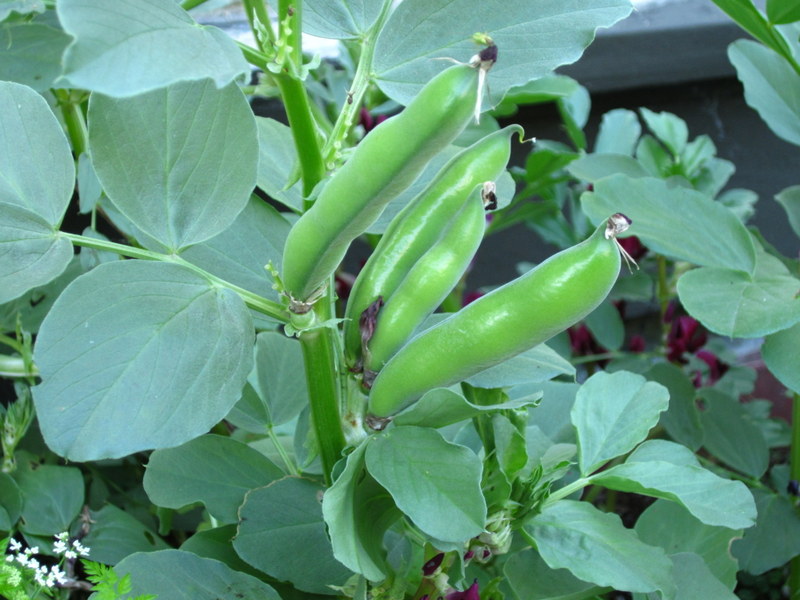Before gas and electricity were available for refrigeration, freezing, dehydrating and cooking, an easy method of food preservation, also known as lacto-fermentation, was used by our ancestors all over the world who had crocks full of soured cabbage, cucumber pickles, beets, onions or garlic in the root cellar.
St. Patrick's Organic Community Garden
Root Cellars Rock had the wonderful good fortune of being toured around the St. Patrick's Organic Community Garden in Carbonear this past Thursday. The garden is almost brand new, launched just this spring. It's a lovely spot situated on a piece of land that used to be the foundation of a school. After the school was taken down Carbonear gave the community gardeners permission to use the land.
Heat waves and cold snaps
This summer has been something else, hasn't it? My tomatoes are fruiting happily, my zucchini are starting to flower, and even my very-late-started cucumbers look like they might provide me with a few crisp slicers before the frost hits them. It's glorious. However, there's always a price to pay for nice weather. My spring-sown greens - spinach, rapini, arugula and the like - all bolted to high heaven when the hot weather hit. So I missed out on my rapini - one of my very favourite vegetables - again. I've sown some more arugula, and I'll try the rapini and spinach again later this summer for a fall crop. But still, my repeated failure on the rapini front is getting more than a little discouraging. Fall had better be good to me.
I may have had success with my garlic, but of course I can't tell until I dig it up. If it has formed decent-sized bulbs I'll be super impressed, since I don't think I got it in the ground until after Christmas (the recommended time for planting garlic being, oh, around October). Here's the thing, though: if my garlic is ready to come up within the next few weeks, as it looks like it will be, then what am I going to plant in my newly-emptied garlic bed? On one hand, it's exciting to have a bunch of garden space come available., especially now that almost every corner of my garden is full to capacity. On the other, filling a bed in part shade with something that will be up and out of the ground by the time I have to plant next year's garlic (some time before Christmas this year, fingers crossed) is a lot of pressure. What grows that fast? Radishes and lettuce, I suppose. Nothing wrong with radishes and lettuce.
Just across the yard from my speedy garlic is my very confused broccoli. Actually, it's called purple sprouting broccoli. It's very common in British home gardens, where it is known as one of the few vegetables that grows through the winter to provide fresh eats in the early spring; normally, transplants are planted out in the spring so the plant can grow over the summer. Then the plant stands through the winter and produces lovely purple florets in March and April. Well, I planted mine out in spring, just like it said to on the package. Then the weather got really hot. Then it got really cold. Then it got really hot again, and now my purple sprouting broccoli is sprouting, about eight months ahead of schedule. Did the frost in June convince my purple sprouting broccoli that it had survived a winter? Will my broccoli keep on sprouting into the fall and winter, or will it bolt and fizzle out? And what am I going to eat in March?
Finally, my broad beans (fava beans) are attempting to live again. They flowered spectacularly in the spring, delighting the eye and perfuming the evenings with the most divine scent. I pinched out the young growing tips of each plant and ate them as luscious salad greens. Then it got hot out and almost all the flowers fell off before setting fruit. So for all those lush red blossoms, I'm going to get a handful of beans. Sigh. All hope is not lost, though; pinching out the growing tips has made the bean plants send out side shoots, which means more flowers. Maybe these ones will have cooler weather when it comes time to set fruit, and I'll have... two handfuls of beans.
Oh, my garden. Confused, off-schedule, and in too deep. But would I have it any other way?
Built to Last
 In the late 1800's this root cellar played an important role in farm life at Riverside Farm, once located on Portugal Cove Road in St. John's. Root Cellars Rock was contacted by Stan Lawlor, now living in northern Ontario, who's great-great grandfather built the cellar. He recalls, "as a child, this root cellar was an essential part of my activities, as I helped my family sow, cultivate and harvest potatoes, turnips, carrots, parsnips, lettuce, cabbage, beets, savoury, etc. for family consumption throughout the winter...As a young person in the 1950 and 1960s, I spent many hours storing and carrying vegetables in that cellar."
In the late 1800's this root cellar played an important role in farm life at Riverside Farm, once located on Portugal Cove Road in St. John's. Root Cellars Rock was contacted by Stan Lawlor, now living in northern Ontario, who's great-great grandfather built the cellar. He recalls, "as a child, this root cellar was an essential part of my activities, as I helped my family sow, cultivate and harvest potatoes, turnips, carrots, parsnips, lettuce, cabbage, beets, savoury, etc. for family consumption throughout the winter...As a young person in the 1950 and 1960s, I spent many hours storing and carrying vegetables in that cellar."
Stan talked about the amount of work that went into building the cellar: "the root cellar is an 8 - 10 feet deep excavation that was dug by hand and it is lined with large boulders which were placed manually. It is a bit of an architectural masterpiece, even if I do say so myself...I was always astounded at the size of the rocks that my great grandfather placed in the days before modern machine technology. Absolutely no mortar was used in the construction of the cellar. Also, the rock walls have never required repair over the 60 years that I remember the cellar."
It's now over a hundred years since the root cellar was constructed, and Stan's family still lives on the property, although it's no longer a farm. His brother continues to store vegetables in the cellar purchased in bulk from local farmers, as well as his own homemade wine.
In today's world, centred around disposable items, root cellars seem like a marvel of dependability. Built generations ago for a practical purpose, and if cared for, still able to serve that purpose today. There are not many things being created these days that can boast that promise of longevity.
That's why FSN chose root cellars as the symbol of our local food project and named the project Root Cellars Rock. We're working to develop a strong foundation for local food in this province that's also built to last. Certainly this blog is about more than root cellars, but they're at the heart of our food traditions. We're hoping that root cellars and Root Cellars Rock inspire people towards sustainable living, self-sufficiency, and commitment to a thriving local food system.
To find out how to build, stock and maintain a root cellar, visit our Root Cellars Food Skills Workshop. If you have a root cellar, old or new, and would like to share your story about it like Stan did, please contact info@rootcellarsrock.ca.
Pictures and some of the information for this post came from the Root Cellars Traditions collection in the MUN Digital Archives, created by Intangible Cultural Heritage and the Agricultural History Society. Visit that collection to learn a lot more about this province's cellars.















